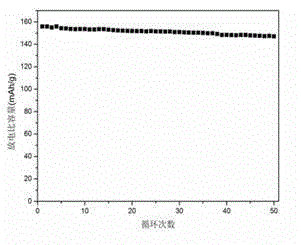Method for recycling and preparing lithium iron manganese phosphate from positive electrode materials of waste lithium iron phosphate batteries
A lithium iron phosphate battery, lithium iron manganese phosphate technology, applied in battery recycling, waste collector recycling, recycling technology and other directions, can solve the problems of incomplete recycling, low recovery rate, etc., to solve the recycling problem and improve the working voltage Effect
- Summary
- Abstract
- Description
- Claims
- Application Information
AI Technical Summary
Problems solved by technology
Method used
Image
Examples
Embodiment 1
[0025] 1) Discharge the residual power of the waste lithium iron phosphate battery, disassemble the battery, separate the positive electrode, negative electrode and separator, wash the positive electrode and dry it;
[0026] 2) Heat-treat the dried positive electrode sheet at 450°C for 3 hours in a muffle furnace, separate the heat-treated lithium iron phosphate from the aluminum foil, and recycle the aluminum foil by smelting;
[0027] 3) Take 50g of the lithium iron phosphate separated in the previous step and add 199ml of 4mol / L hydrochloric acid to the oil bath at 70°C. After stirring for 5 hours, filter to separate the solid and liquid, and suction filter to obtain 29.3g of brick red precipitate and filtrate;
[0028] 4) The filtrate is tested and analyzed, and the molar ratio of the elements is n Li :n Fe :n Mn :n p =1:0.2:0.8:1, add manganese carbonate solid 27.7g, ammonium monohydrogen phosphate 18.6g in the obtained filtrate, after stirring and dissolving, control ...
Embodiment 2
[0032] 1) Discharge the residual power of the waste lithium iron phosphate battery, disassemble the battery, separate the positive electrode, negative electrode and separator, wash the positive electrode and dry it;
[0033] 2) After heat-treating the dried positive electrode sheet at 500°C for 2 hours in a muffle furnace, the heat-treated lithium iron phosphate and aluminum foil are separated, and the aluminum foil is recovered by smelting;
[0034] 3) Take 50g of the lithium iron phosphate separated in the previous step and add 199ml of 4mol / L nitric acid in an oil bath at 80°C. After stirring for 4 hours, filter to separate the solid and liquid, and suction filter to obtain 24.7g of brick-red precipitate and filtrate;
[0035] 4) The filtrate is tested and analyzed, and the molar ratio of the elements is n Li :n Fe :n Mn :n p =1:0.3:0.7:1, add manganese nitrate solid 37.7g, ammonium hydrogen phosphate 16.5g in the obtained filtrate, after stirring and dissolving, control...
Embodiment 3
[0039] 1) Discharge the residual power of the waste lithium iron phosphate battery, disassemble the battery, separate the positive electrode, negative electrode and separator, wash the positive electrode and dry it;
[0040]2) After the dried positive electrode sheet is heat-treated in a muffle furnace at 600°C for 1 hour, the heat-treated lithium iron phosphate is separated from the aluminum foil, and the aluminum foil is recycled by smelting;
[0041] 3) Take 100g of the lithium iron phosphate separated in the previous step and add 113ml of 4mol / L sulfuric acid to the oil bath at 90°C. After stirring for 3 hours, filter to separate the solid and liquid, and suction filter to obtain 40.2g of brick-red precipitate and filtrate;
[0042] 4) The filtrate is tested and analyzed, and the molar ratio of the elements is n Li :n Fe :n Mn :n p =1:0.4:0.6:1, add manganese nitrate solid 62.5g, ammonium dihydrogen phosphate 18.5g to the obtained filtrate, after stirring and dissolving...
PUM
 Login to View More
Login to View More Abstract
Description
Claims
Application Information
 Login to View More
Login to View More - R&D
- Intellectual Property
- Life Sciences
- Materials
- Tech Scout
- Unparalleled Data Quality
- Higher Quality Content
- 60% Fewer Hallucinations
Browse by: Latest US Patents, China's latest patents, Technical Efficacy Thesaurus, Application Domain, Technology Topic, Popular Technical Reports.
© 2025 PatSnap. All rights reserved.Legal|Privacy policy|Modern Slavery Act Transparency Statement|Sitemap|About US| Contact US: help@patsnap.com


